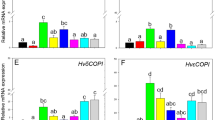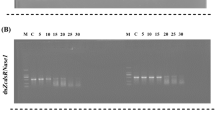Abstract
Double-stranded RNA (dsRNA) designed to target genes in a sequence-specific manner can be valuable in pest control. However, in scenarios where a nontarget could be susceptible and is predicted to be exposed to insecticidal dsRNA in the environment, it is useful to understand possible gene silencing effects in the nontarget. In this study, a sequence complementarity-based approach was used to evaluate potential gene silencing effects in the bumblebee, Bombus terrestris, following oral exposure to a fusion dsRNA product (Ba-dsCOP-vg) specifically designed to target both alpha-coatomer (alphaCOP) and vitellogenin (vg) in the pest pollen beetle, Brassicogethes aeneus. The susceptibility of bumblebees to ingested dsRNA was first evaluated by feeding them with bumblebee-specific dsRNA (Bt-dsCOP-vg) (1 µg/µl) targeting its alphaCOP and vg. A respective 50% and 47% reduction in the transcripts of alphaCOP and vg at 96 h post exposure confirmed its susceptibility to the ingested dsRNA. Using computational tools, a pool of all possible continuous 22-nucleotide stretches from Ba-dsCOP-vg was generated and mapped to all potential off-target genes in the B. terrestris genome, with at least a 13-nt match within the 22-nt stretch. A set of criteria based on sequence complementarity was then used to select 24 potential off-targets for transcript analysis in bumblebees. Following ingestion of Ba-dsCOP-vg (1 µg/µl), no reduction was found in the transcript level for all off-targets, including an off-target with 20-continuous-nt matches. Our findings provide guidance to future risk analysis of dsRNA products and for risk assessments frameworks that incorporate sequence complementarity-based analysis for off-target predictions.







Similar content being viewed by others
Availability of data and material
Datasets related to the present study are available in the supplementary, and additional information can be made available upon request from the corresponding authors.
Code availability
The python script used in this study has been included in the Online Resource file attached to this manuscript.
References
Alemán LM, Doench J, Sharp PA (2007) Comparison of siRNA-induced off-target RNA and protein effects. RNA 13:385–395. https://doi.org/10.1261/rna.352507
Arvey A, Larsson E, Sander C et al (2010) Target mRNA abundance dilutes microRNA and siRNA activity. Mol Syst Biol 6:363. https://doi.org/10.1038/msb.2010.24
Baum JA, Bogaert T, Clinton W et al (2007) Control of coleopteran insect pests through RNA interference. Nat Biotechnol 25:1322–1326. https://doi.org/10.1038/nbt1359
Bachman PM, Bolognesi R, Moar WJ et al (2013) Characterization of the spectrum of insecticidal activity of a double-stranded RNA with targeted activity against Western Corn Rootworm (Diabrotica virgifera virgifera LeConte). Trans Res 22:1207–1222. https://doi.org/10.1007/s11248-013-9716-5
Bolognesi R, Ramaseshadri P, Anderson J et al (2012) Characterizing the mechanism of action of double-stranded RNA activity against western corn rootworm (Diabrotica virgifera virgifera LeConte). PLoS ONE. https://doi.org/10.1371/journal.pone.0047534
Buchon N, Silverman N, Cherry S (2014) Immunity in Drosophila melanogaster—from microbial recognition to whole-organism physiology. Nat Rev Immunol 14:796–810. https://doi.org/10.1038/nri3763
Cagliari D, Dias N, Avila Dos Santos E, Galdeano DM, Smagghe G, Zotti MJ (2019) Management of pest insects and plant diseases by non-transformative RNAi. Frontiers Plant Sci 10:1319. https://doi.org/10.3389/fpls.2019.01319
Chen A, Zheng W, Zheng W, Zhang H (2015) The effects of RNA interference targeting Bactrocera dorsalis ds-Bdrpl19 on the gene expression of rpl19 in non-target insects. Ecotoxicology 24:595–603. https://doi.org/10.1007/s10646-014-1407-3
Christiaens O, Whyard S, Vélez AM, Smagghe G (2020) Double-stranded RNA technology to control insect pests: current status and challenges. Front Plant Sci 11:451. https://doi.org/10.3389/fpls.2020.00451
Christiaens O, Dzhambazova T, Kostov K et al (1424E) Literature review of baseline information on RNAi to support the environmental risk assessment of RNAi-based GM plants. EFSA Support Publ 15:1424E. https://doi.org/10.2903/sp.efsa.2018.EN-1424
Cruz C, Tayler A, Whyard S (2018) RNA interference-mediated knockdown of male fertility genes in the Queensland fruit fly Bactrocera tryoni (Diptera: Tephritidae). Insects 9:96. https://doi.org/10.3390/insects9030096
Dong K, Sun L, Liu JT et al (2017) RNAi-induced electrophysiological and behavioral changes reveal two pheromone binding proteins of Helicoverpa armigera involved in the perception of the main sex pheromone component Z11–16: Ald. J Chem Ecol 43:207–214. https://doi.org/10.1007/s10886-016-0816-6
Du Q, Thonberg H, Wang J, Wahlestedt C, Liang Z (2005) A systematic analysis of the silencing effects of an active siRNA at all single-nucleotide mismatched target sites. Nucleic Acids Res 33:1671–1677. https://doi.org/10.1093/nar/gki312
Duan JJ, Lundgren JG, Naranjo S, Marvier M (2010) Extrapolating non-target risk of Bt crops from laboratory to field. Biol Lett 6:74–77. https://doi.org/10.1098/rsbl.2009.0612
Fishilevich E, Bowling AJ, Frey ML et al (2019) RNAi targeting of rootworm Troponin I transcripts confers root protection in maize. Insect Biochem Mol Biol 104:20–29. https://doi.org/10.1016/j.ibmb.2018.09.006
Freitak D, Wheat CW, Heckel DG, Vogel H (2007) Immune system responses and fitness costs associated with consumption of bacteria in larvae of Trichoplusia ni. BMC Biol 5:56. https://doi.org/10.1186/1741-7007-5-56
Gerich B, Orci L, Tschochner H et al (1995) Non-clathrin-coat protein alpha is a conserved subunit of coatomer and in Saccharomyces cerevisiae is essential for growth. Proc Natl Acad Sci USA 92:3229–3233. https://doi.org/10.1073/pnas.92.8.3229
Goulson D (2010) Bumblebees as pollinators, in Bumblebees, behaviour, ecology and conservation. Oxford University Press, Oxford
Haller S, Widmer F, Siegfried BD, Zhuo X, Romeis J (2019) Responses of two ladybird beetle species (Coleoptera: Coccinellidae) to dietary RNAi. Pest Manag Sci 75:2652–2662. https://doi.org/10.1002/ps.5370
Hanning JE, Saini HK, Murray MJ et al (2013) Lack of correlation between predicted and actual off-target effects of short-interfering RNAs targeting the human papillomavirus type 16 E7 oncogene. Br J Cancer 108:450–460. https://doi.org/10.1038/bjc.2012.564
Hong SW, Jiang Y, Kim S et al (2014) Target gene abundance contributes to the efficiency of siRNA-mediated gene silencing. Nucleic Acid Ther 24:192–198. https://doi.org/10.1089/nat.2013.0466
Huvenne H, Smagghe G (2010) Mechanisms of dsRNA uptake in insects and potential of RNAi for pest control: A review. J Insect Physiol 56:227–235. https://doi.org/10.1016/j.jinsphys.2009.10.004
Kulkarni MM, Booker M, Silver SJ et al (2006) Evidence of off-target effects associated with long dsRNAs in Drosophila melanogaster cell-based assays. Nat Methods 3:833–838. https://doi.org/10.1038/nmeth935
Lee KY, Yim SH, Seo HJ, Shin M, Yoon HJ (2017) Pollination Efficiency of Honeybees (Apis mellifera L.) and Bumblebees (Bombus terrestris L.) in Different Cultivars of Asian Pear (Pyrus pyrifolia Nakai). J Apic 32:303–314. https://doi.org/10.17519/apiculture.2017.11.32.4.303
Liu Q, Wang F, Axtell MJ (2014) Analysis of complementarity requirements for plant microRNA targeting using a Nicotiana benthamiana quantitative transient assay. Plant Cell 26:741–753. https://doi.org/10.1105/tpc.113.120972
Ma Y, Creanga A, Lum L, Beachy PA (2006) Prevalence of off-target effects in Drosophila RNA interference screens. Nature 443:359–363. https://doi.org/10.1038/nature05179
Mao YB, Cai WJ, Wang JW et al (2007) Silencing a cotton bollworm P450 monooxygenase gene by plant-mediated RNAi impairs larval tolerance of gossypol. Nat Biotechnol 25:1307–1313. https://doi.org/10.1038/nbt1352
Miller SC, Miyata K, Brown SJ, Tomoyasu Y (2012) Dissecting systemic RNA interference in the red flour beetle Tribolium castaneum: parameters affecting the efficiency of RNAi. PLoS ONE. https://doi.org/10.1371/journal.pone.0047431
Mogren CL, Lundgren JG (2017) In silico identification of off-target pesticidal dsRNA binding in honey bees (Apis mellifera). PeerJ 5:e4131. https://doi.org/10.7717/peerj.4131
Niu J, Cappelle K, de Miranda JR, Smagghe G, Meeus I (2014) Analysis of reference gene stability after Israeli acute paralysis virus infection in bumblebees Bombus terrestris. J Invertebr Pathol 115:76–79. https://doi.org/10.1016/j.jip.2013.10.011
Niu J, Smagghe G, De Coninck DIM et al (2016) In vivo study of Dicer-2-mediated immune response of the small interfering RNA pathway upon systemic infections of virulent and avirulent viruses in Bombus terrestris. Insect Biochem Mol Biol 70:127–137. https://doi.org/10.1016/j.ibmb.2015.12.006
Okamura K, Ishizuka A, Siomi H, Siomi MC (2004) Distinct roles for Argonaute proteins in small RNA-directed RNA cleavage pathways. Genes Dev 18:1655–1666. https://doi.org/10.1101/gad.1210204
Pan H, Xu L, Noland JE et al (2016) Assessment of potential risks of dietary rnai to a soil micro-arthropod, Sinella curviseta Brook (Collembola: Entomobryidae). Front Plant Sci 7:1028. https://doi.org/10.3389/fpls.2016.01028
Pérez-Méndez N, Andersson GK, Requier F et al (2020) The economic cost of losing native pollinator species for orchard production. J Appl Ecol 57:599–608. https://doi.org/10.1111/1365-2664.13561
Qiu S, Adema CM, Lane T (2005) A computational study of off-target effects of RNA interference. Nucleic Acids Res 33:1834–1847
Ramon M, Devos Y, Lanzoni A et al (2014) RNAi-based GM plants: Food for thought for risk assessors. Plant Biotechnol J 12:1271–1273. https://doi.org/10.1111/pbi.12305
Romeis J, Meissle M, Alvarez-Alfageme F et al (2014) Potential use of an arthropod database to support the non-target risk assessment and monitoring of transgenic plants. Trans Res 23:995–1013. https://doi.org/10.1007/s11248-014-9791-2
Sadd BM, Barribeau SM, Bloch G et al (2015) The genomes of two key bumblebee species with primitive eusocial organization. Genome Biol 16:76. https://doi.org/10.1186/s13059-015-0623-3
Santos D, Mingels L, Vogel E et al (2019) Generation of virus-and dsRNA-derived siRNAs with species-dependent length in insects. Viruses 11:738. https://doi.org/10.3390/v11080738
Sapir G, Baras Z, Azmon G et al (2017) Synergistic effects between bumblebees and honey bees in apple orchards increase cross pollination, seed number and fruit size. Sci Hortic 219:107–117. https://doi.org/10.1016/j.scienta.2017.03.010
Schonbaum CP, Perrino JJ, Mahowald AP (2000) Regulation of the vitellogenin receptor during Drosophila melanogaster oogenesis. Mol Biol Cell 11:511–521. https://doi.org/10.1091/mbc.11.2.511
Schwenke RA, Lazzaro BP, Wolfner MF (2016) Reproduction–immunity trade-offs in insects. Annu Rev Entomol 61:239–256. https://doi.org/10.1146/annurev-ento-010715-023924
Sigoillot FD, King RW (2011) Vigilance and validation: Keys to success in RNAi screening. ACS Chem Biol 6:47–60. https://doi.org/10.1021/cb100358f
Taning CNT, Andrade EC, Hunter WB, Christiaens O, Smagghe G (2016a) Asian citrus psyllid RNAi pathway–RNAi evidence. Sci Rep 6:38082. https://doi.org/10.1038/srep38082
Taning CNT, Arpaia S, Christiaens O et al (2019a) RNA-based biocontrol compounds: current status and perspectives to reach the market. Pest Manag Sci 76:841–845. https://doi.org/10.1002/ps.5686
Taning CNT, Christiaens O, Berkvens N, Casteels H, Maes M, Smagghe G (2016b) Oral RNAi to control Drosophila suzukii: laboratory testing against larval and adult stages. J Pest Sci 89:803–814. https://doi.org/10.1007/s10340-016-0736-9
Taning CNT, Vanommeslaeghe A, Smagghe G (2019b) With or without foraging for food, field-realistic concentrations of sulfoxaflor are equally toxic to bumblebees (Bombus terrestris). Entomol Gen. https://doi.org/10.1127/entomologia/2019/0784
Vélez AM, Jurzenski J, Matz N et al (2016) Developing an in vivo toxicity assay for RNAi risk assessment in honey bees, Apis mellifera L. Chemosphere 144:1083–1090. https://doi.org/10.1016/j.chemosphere.2015.09.068
Vélez AM, Fishilevich E, Rangasamy M et al (2020) Control of western corn rootworm via RNAi traits in maize: lethal and sublethal effects of Sec23 dsRNA. Pest Manag Sci 76:1500–1512. https://doi.org/10.1002/ps.5666
Velthuis HH, Van Doorn A (2006) A century of advances in bumblebee domestication and the economic and environmental aspects of its commercialization for pollination. Apidologie 37:421–451. https://doi.org/10.1051/apido:2006019
Whyard S, Singh AD, Wong S (2009) Ingested double-stranded RNAs can act as species-specific insecticides. Insect Biochem Mol Biol 39:824–832. https://doi.org/10.1016/j.ibmb.2009.09.007
Yang L, Tian Y, Peng YY, Niu J, Wang JJ (2020) Expression dynamics of core RNAi machinery genes in pea aphids upon exposure to artificially synthesized dsRNA and miRNAs. Insects 11:70. https://doi.org/10.3390/insects11020070
Yoon JS, Koo J, George S, Palli SR (2020) Evaluation of inhibitor of apoptosis genes as targets for RNAi-mediated control of insect pests. Arch Insect Biochem Physiol. https://doi.org/10.1002/arch.21689
Zhang H, Li H, Guan R, Miao X (2015) Lepidopteran insect species-specific, broad-spectrum, and systemic RNA interference by spraying dsRNA on larvae. Entomol Exp Appl 155:218–228. https://doi.org/10.1111/eea.12300
Acknowledgements
The authors acknowledge Dries Van Herpe (VIB-UGent Center for Medical Biotechnology) for helping with the python script used for the in silico predictions.
Funding
This study was partially funded by the European ERA-NET C-IPM project “IPM4Meligethes” (project no 3G0H0416), the Special Research Fund (BOF) of Ghent University and the Research Foundation—Flanders (FWO-Vlaanderen). Olivier Christiaens is a recipient of a postdoctoral fellowship from the Research Foundation—Flanders (FWO-Vlaanderen).
Author information
Authors and Affiliations
Corresponding authors
Ethics declarations
Conflict of interest
The authors declare that the research was conducted in the absence of any commercial or financial relationships that could be construed as a potential conflict of interest.
Ethics approval
This study does not contain any experiments using any animal species that require ethical approval.
Consent to participate
Consent was given by all participants included in the study.
Consent for publication
All authors consent to the publication of this manuscript in Journal of Pest Science.
Additional information
Communicated by Chris Cutler Antonio.
Publisher's Note
Springer Nature remains neutral with regard to jurisdictional claims in published maps and institutional affiliations.
Electronic supplementary material
Below is the link to the electronic supplementary material.
Rights and permissions
About this article
Cite this article
Taning, C.N.T., Gui, S., De Schutter, K. et al. A sequence complementarity-based approach for evaluating off-target transcript knockdown in Bombus terrestris, following ingestion of pest-specific dsRNA. J Pest Sci 94, 487–503 (2021). https://doi.org/10.1007/s10340-020-01273-z
Received:
Revised:
Accepted:
Published:
Issue Date:
DOI: https://doi.org/10.1007/s10340-020-01273-z




